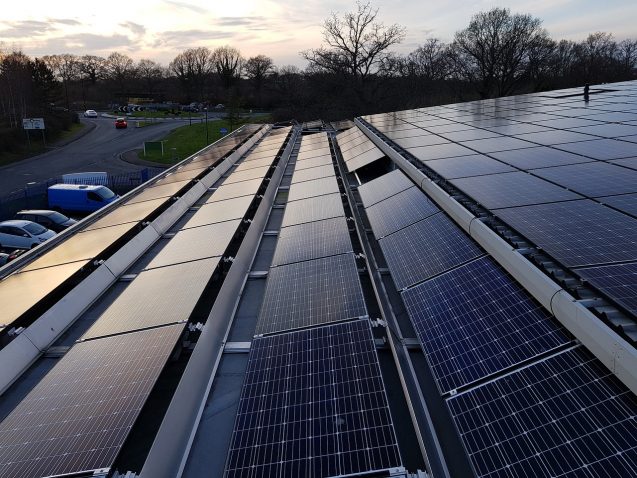Dear Homeowner,
For decades, we’ve relied on an energy system that chokes our skies with pollution and drains our wallets. But today, we stand at a turning point where we can choose a path that not only preserves our ecosystem but also safeguards our future. Few home upgrades instantly increase property value, slash monthly utility bills and save thousands over time. Installing solar panels is one of them. Every year you wait, you leave money on the table. Electricity rates keep rising. Incentives won’t last forever. The best time to go solar? Right now.
The federal solar tax credit currently covers 30% of your system’s cost under the Inflation Reduction Act (IRA), but its future is uncertain. The new administration has rolled back over 30 environmental rules and criticized the IRA, calling it the “Green New Scam.” With this shift in policy, renewable energy incentives—including IRA-rooted tax credits—are at risk of being reduced, if not eliminated. Tariffs on steel and aluminum are also likely to drive up the cost of solar panels. Installing solar today locks in savings while reducing reliance on fossil fuels. According to the U.S. Energy Information Administration, nominal electricity prices have increased by 33% (from 12 cents to 16 cents per kilowatt hour) over the past decade.
Once considered a niche environmental choice, solar has now become a mainstream and pragmatic solution to rising utility bills. In other words, solar isn’t just good for the environment, it makes financial sense. Let’s take a look at the arithmetic.
For the sake of simplicity, say you purchased a $1,000,000 home and are debating a $20,000 solar installation. With the current federal tax credit, you’d immediately save $6,000, bringing your net cost to $14,000. That’s still a significant upfront investment, but a Zillow study found that homes with solar panels sell for 4.1% more than comparable homes. A more recent study found that figure to be 6.8%. That means your home’s value would increase by $41,000 to $68,000 the moment the system is installed.
Over 20 years, assuming your solar panels cut a $100 monthly electric bill by 60% (saving $720 per year), you’d save $14,400—more than your initial investment. The question of whether you’ll stay in your home long enough to “break even” is irrelevant. Solar adds value from day one, making your home more attractive to buyers whenever you decide to sell.
If you’re concerned about upfront costs, financing is also an option. A 20-year loan at 6% interest (current rate) would mean a $143 monthly payment. Your system would cover the majority of the loan payment, and once it’s paid off, all savings go straight to your pocket. Meanwhile, utility rates will keep rising, but your solar costs remain fixed, making your investment more valuable over time.
And the financial benefits of solar don’t stop at your electric bill. Many local utilities also offer incentives to make solar more affordable. In my hometown of Austin, TX, our electricity provider, Austin Energy, offers a $2,500 rebate that you can take whole or apply toward financing to reduce monthly costs. Many other cities, from Los Angeles to New York, also offer worthwhile incentives.
When the U.S. imposed a 30% tariff on imported solar panels in 2018, it resulted in an estimated 35% price increase to the American consumer, slowing adoption and resulting in a loss of $19 billion in private sector solar investments. It’s encouraging to see that, despite these challenges, the solar industry grew by 128% during the first Trump administration. However, with a new universal 10% tariff and a 25% tariff on steel and aluminum, we’re likely to see slowdown in adoption again. Homeowners who install solar today can lock in current prices before costs inevitably rise.
“The financial benefits alone make solar an obvious choice, but its impact goes far beyond your wallet. With every panel installed, we step closer to a future where clean energy is the norm, not the exception.”
Pairing solar with other green choices amplifies both savings and impact. Switching to an electric vehicle means fueling your car with energy from sunlight instead of fossil fuels, cutting gas costs while reducing smog and the urban heat island effect. Smart home upgrades like energy-efficient appliances or heat pumps further lower your energy use, maximizing your solar investment. These choices add up, turning your home into a self-sufficient system where energy costs are predictable, bills are lower and you’re no longer at the mercy of rising utility and fuel prices. Solar panels on your roof aren’t just a one-time upgrade—they’re the foundation for a future where your home works for both you and the environment.
The financial benefits alone make solar an obvious choice, but its impact goes far beyond your wallet. With every panel installed, we step closer to a future where clean energy is the norm, not the exception. Imagine a world where the hum of fossil fuel plants fades into memory, where the air is crisp, the skies clear and the energy that powers our homes comes not from the slow destruction of our planet, but from the boundless power of the sun.
Each solar panel installed is a quiet rebellion against a system that has long been held hostage by the fossil fuel industry and accelerated the warming of our fragile Earth. By choosing solar, you are not just making a financially sound investment; you are taking a stand for the generations that will walk this planet long after us. You are saying that the forests, the oceans and the delicate balance of life deserve better.
With optimism for a brighter future,
Daryush Nourbaha
Daryush Nourbaha, a graduate of Columbia’s M.S. in Science in Sustainability Science program, is an environment, health, safety and sustainability manager at Collins Aerospace.
Views and opinions expressed here are those of the authors, and do not necessarily reflect the official position of the Columbia Climate School, Earth Institute or Columbia University.
Source link
Guest news.climate.columbia.edu



